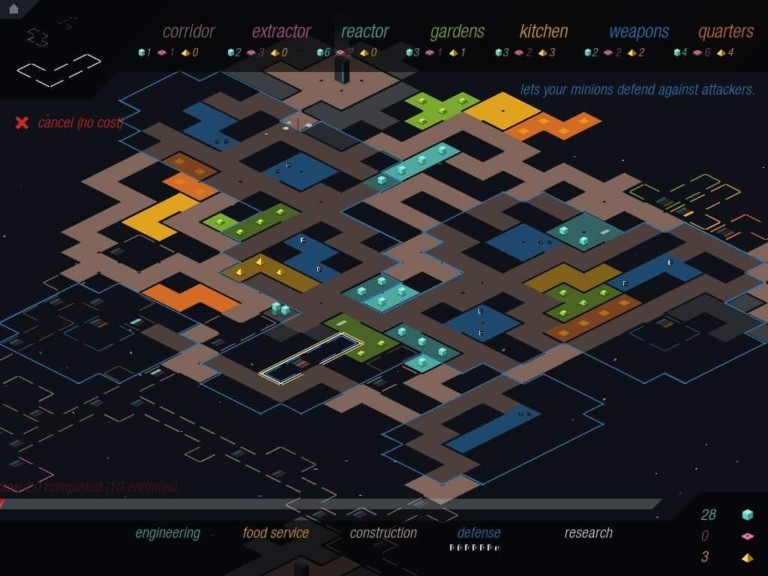Rymdkapsel Review
Rymdkapsel, which means “space capsule” in Swedish, is a beautifully flat-designed game for iOS and Android wherein you build an optimal space fortress that can support your colony, while in anticipation of attacks from trawling celestial ne’er-do-wells.
First things first: I highly recommend playing this on a tablet rather than a phone as the tiny elements are not nearly as easy to contend with in the smaller format and this may radically influence your experience playing the game.
Start Me Up
You begin by selecting the next randomly chosen Tetromino in the queue, you drag/swipe the desired unit type to build corridors, extractors, reactors, gardens – where you develop sludge that is submitted to kitchens for processing, weapons which become essential to continuing the play, and living quarters to produce more minions without which you will eventually die out, particularly as the vicious attacks on your colony escalate.

At first blush, I was a bit overwhelmed by the interface, though a gentle tutorial guided me through (the first round of every game repeats the tutorial steps, though you can toggle off the prompts in the settings menu).
Once I had executed the basic commands, I couldn’t figure out how to get my minions to wake up and actually do something. They appeared to love sleeping on the job. Maybe it was the lack of food? (Turns out, it was the lack of tasks to complete in given assignment, in other words, they had finished their assigned duties and need to be delegated elsewhere.)
Throughout all this I was kept company by a music score that felt a bit like Tangerine Dream on a lazy day, but it helped engender the idea that I was in some kind of outer space Kubrickian dimension. The sound effects are terrific, lending enough punch and impact to deliver the full experience, in spite of their 8-bit leanings. My favorite sound was the huge moaning sirens that sounded when the enemies were coming in to attack – it reminded me of the creepy harbinger trumpets in the 1990\s film The Rapture starring Mimi Rogers.
Also, as I was only just becoming familiar with the game mechanics, the inability to speed up time/fast-forward made it feel a bit grindy, but after a few embarrassing failures, I came to appreciate these contemplative, slower paced early phases as the time to think through forward-looking organization of my corridors, planning ten steps ahead like a Beatle laying out how to record Sgt. Pepper onto only four multitrack channels.
Room With A View
So the basics are: Rooms can only connect to corridors, not other rooms. Moreover, you will begin to deplete your finite resources so don’t even think about getting build-happy before knowing how to manage them. Some are exhaustible, others only function if their prerequisite units are already in place To create new minions you must provide “food service” at the cost of two meals per minion, and in order to do so you must have a garden, kitchen and (resource-hungry) quarters set up.

In the first few rounds, things move along at a leisurely pace as you decide what to do with the next shape that comes up.
You see, Rymdkapsel is Tetris turned into Populous, with elements of of a time-management/simulation game, wherein you must cultivate the land and feed your minions, all the while establishing sufficient resources for when you must go to war – a causality that comes in shorter and sweat-inducingly shorter intervals, whereupon you must interrupt your various minions’ developmental activities and rush them into their combat suits lest they be left prone to the incoming lasers – death from above. This final stage of each round feels a lot like Missile Command. Thus we have a title that encapsulates many of the most beloved tropes, but in such a way that it does not feel cobbled together, but rather like one seamless and natural eventuality.

The objectives are to expand your space fort to the various energy pools where you build extractors, and also to build corridors to the front gates of monoliths that encircle you. Once you have completed a road to a monolith’s front steps, the option to do research becomes available. While this is not completely necessary, it is an achievement, and doing so in under 45 minutes is a second achievement.
Ignore the time-consuming research at your peril; successfully researched monoliths will afford you distinct advantages needed to defeat your predators. The resulting upgrades include longer weapons reach, faster minions, longer delays between enemy attacks and so on. You cannot choose the result of the research like you might in a traditional tech tree, but the extra boost they give you will become nearly critical to your survival.

Star Maps
My first two games, which lasted roughly half an hour each, were, in retrospect, noobish to a fault. But by my third consecutive outing, I grok’d that this is called Space Capsule – it is all about the layout of your space station. The clever and careful placement of your corridors – the connective tissue between your various resource generating hubs, is paramount.
Due to the fact that the shape of your next tile is randomized among the set of possible Tetris-like shapes, levels are essentially procedurally generated and so, despite the fact that the various outposts to which you aspire to connect in order to perform research are in the same configuration at the start of each game, no two games will ever be the same.

I cannot recommend this game highly enough. It offers impeccable design, advanced AI, and a brilliant use of minimalistic abstraction that, though primitive to the extreme, still evokes a deep sense of immersion and even symptomatic narrative. I could not believe that I could feel for 1 mm tall white polygons, but I did. I caught myself on more than one occasion, projecting memories of Ender’s Game or The Last Starfighter onto the proceedings.
The game has only two people credited: Martin Jonasson doing all the design, visuals and programming and music and sound by Niklas Ström – an astounding feat.
I could spend many more hours, and just as many words, imparting the thrills and excitement the game elicited, but you don’t need to read me blabbering on about it any more – for less than five bucks, the experience can be all your own.
The game feels hyperminimalistic at first, but hours are rapidly expended in pursuit of a higher survival time. Populous comparisons aside, this is a unique title that is as good as it gets on the iPad in evoking tension, fascination and engagement. Any other comers in the iOS space will have a difficult time unseating Rymdkapsel for my vote for indie mobile GotY thus far.
Highly recommended.
Get Rymdkapsel for Android at the Google Play Store
Get Rymdkapsel at the iTunes App Store
[xrr rating=”5\5″]




